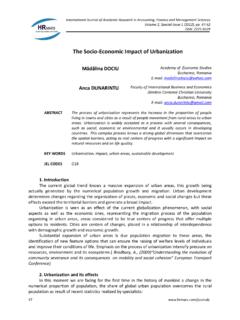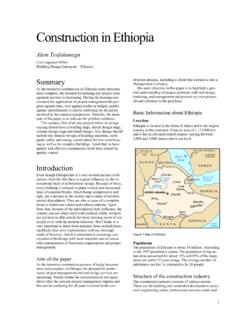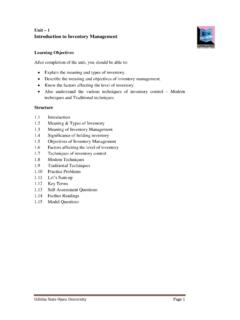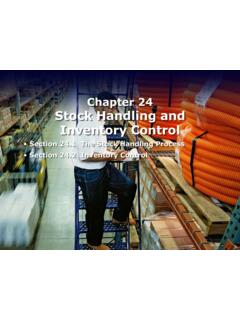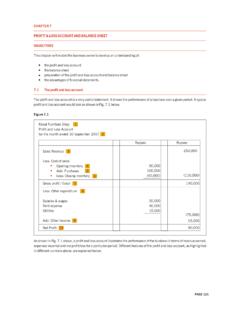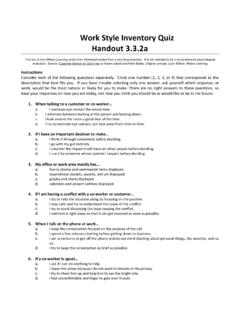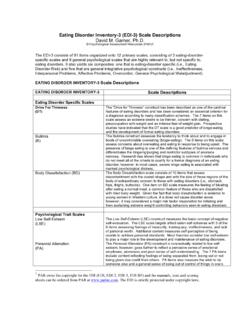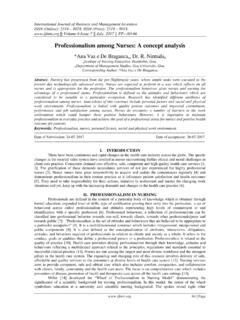Transcription of Warehousing and Inventory Management - Humanitarian …
1 Page 1 Warehousing and Inventory Management1 Definition2 Global Warehouses3 Field Warehouses4 Policies and Procedures5 Types of Warehouse Space6 Basic Principles of Warehouse and Inventory Management7 How to Select and Set-Up a Warehouse8 Determining Storage Requirements9 Warehouse Preparation Planning10 Aspects to consider when managing Warehouse Operations11 Managing Inventory Levels12 Stock control and movements13 Resource Requirements14 Legal Considerations15 Conclusion16 References17 Additional InformationDefinitionA simple definition of a warehouse is: A warehouse is a planned space for the storage and handling of goods and material. ()Fritz InstituteIn general, warehouses are focal points for product and information flow between sources of supply and beneficiaries. However, in Humanitarian supply chains, warehouses vary greatly in terms of their role and their WarehousesThe global Warehousing concept has gained popularity over the last decade as stock pre-positioning becomes one of the strategies for ensuring a timely response to emergencies.
2 They are usually purpose built or purpose designed facilities operated by permanent staff that has been trained in all the skills necessary to run an efficient facility or utilising third party logistics (3PL) staff and facilities. For such operations, organisations use, information systems that are computer based, with sophisticated software to help in the planning and Management of the warehouse. The operating situation is relatively stable and Management attention is focused on the efficient and cost effective running of the warehouse operation. Numerous organizations have centralized pre-positioning units strategically located globally. Some of these offer extended services to other Humanitarian organizations on a cost plus operating charges basis. United Nations Humanitarian Response Depot (UNHRD)Field WarehousesField Warehouses are usually temporary in nature. They may be housed in a buildings which was not designed to be used as a warehouse, in a temporary building/structures, and are often in mobile units (rub halls, Wiikhalls) that are little more than a tent in a field.
3 The initial staff may be a casual workforce that has never worked in a warehouse before and the Inventory system is more likely to be paper based. Often the situation is initially chaotic, sometimes dangerous and coupled with a Humanitarian need which may be very urgent. The Management style must therefore be practical and action oriented with a focus on making the Humanitarian goods available as quickly and efficiently as possible, while being accountable at the same and ProceduresPoliciesThe policies contain hard and fast rules and regulations that define the general conduct of the warehouse operation. Examples of the types of policies that organisations will define are as follows:organisational specific warehouse Management policy and procedures guideline outlinehealth and safetyhuman resources managementsecuritypest controlwarehouse maintenance and cleaningquality controlrecord keeping and reportingreverse logistics Return of goods and exit strategy in the event of downscaling or shutting down operationsdisposal of obsolete and damaged procedures' document defines step by step how the activities in the warehouse should be carried out and clearly defines the processes to be adopted.
4 These can be adopted as best practice .Page 2 The procedures provide visibility of the operations for managers and , in creating such procedures, care must be taken to avoid constraining the use of local initiative which might be required to deal with local conditions. Procedures should be considered as streamlining the business processes and providing checks and balances. They provide guidance to warehouse managers and must have some level of flexibility to cater to unique situations. This can be achieved by limiting the level of detail that the procedures document defines, allowing more flexibility and/or by arranging dispensations to allow departure from the procedures in order to optimise local performance, especially in procedures will normally provide the step by step guidance on how to manage each aspect of Warehousing and may cover:receiving and issuing of supplies;quality control or verification;storage of goods;how to control stock movement (stock control);documentation flow;how to detect and deal with stock losses;how rejected material will be managed; andhow to deal with unwanted material, obsolete and scrap, also a Warehouse Rental Contract of Warehouse SpaceCommercial: in rented building used for or state: such as at the ports or harbours.
5 This is common in emergency : for temporary storage of goods destined for different locations and need storage for a very short warehouses: for storage of goods whose duty is unpaid and especially where the goods are destined to another country. Pre-positioned stock is often held in bonded warehouses so that export is quick and can sometimes be stored for long storage: not ideal for perishable products but in emergencies, sometimes the only that is owned and managed by the warehouses where there are no permanent structures available. This is common practice in Principles of Warehouse and Inventory ManagementPlanning inbound receipt formalities :location managementinventory controloccupational health and safetyOutbound delivery and refer to the Annexes for different samples: , , Inventory Management GuidelinesPerpetual Inventory formStock Count Report formIn/Out Stock .Report formHow to Select and Set-Up a WarehouseDetermining NeedsIn determining needs, one should look beyond the basic need of a warehouse to store things.
6 Whilst, this is correct there are also other volume of goods;speed of through-put required;as a transit point;breaking bulk location;an area for sorting and consolidating different goods;to enhance the speed of the response;to protect and account for inventor; andas a buffer in the event of a break-down or delay in the supply Storage RequirementsSelecting a Suitable LocationThere are a range of factors to consider when deciding on the location of a new warehouse facility and these may vary depending on whether you are selecting a location for a temporary building or selecting from one of a number of existing may include:proximity to ports of entry and beneficiariesexisting buildingssecurityPage 3the contextsite conditionaccessservicesland size availablepurpose of warehouseprevious use of the facilityfloor weightaccess to labourWarehouse SelectionFactors to consider:nature and characteristics of goods to be stored;nature of handling equipment available;duration of storage needed short term or long term;the need for other activities, repackaging, labelling, kitting, etc;access and parking for vehicles;number of loading docks required; andsecure Preparation PlanningSpace layoutThe areas that should be planned are both the general storage areas and the areas for goods receipt, consignment picking and goods dispatch.
7 It is also desirable that space should be set aside for the following activities:equipment maintenance and parking;charging of equipment batteries such as pallet trucks;refuelling of trucks;an area for garbage disposal empty packaging;a quarantine area for keeping rejected goods, goods to be sent back or destroyed;an employee rest area;washroom; andan administration is worth keeping these requirements in mind during the planning of the main operating areas. Planning consideration needs to be given to the following:allocate space for each type of product and locating number;allow sufficient space for easy access to the stacks for inspecting, loading and unloading. Stacks should be one meter from the walls and another meter between stacks;sizing the goods receipt and despatch area;allow space for storage of cleaning materials and supplies;allocate areas for damaged items by consignment number;allow sufficient space to repackage damaged items and place it in separate stacks;sufficient free space is needed to operate a warehouse effectively.
8 When planning the size of a warehouse consider:planning on having about 70-80% utilisation of available space, whilst considering:throughput ratenumber of stock keeping units (SKU)handling characteristics of items, in the guideHow to calculate warehouse storage storage needsSome relief items require special attention in terms of the type and security of the storage area. For example:Medical supplies and drug shipments can contain a large number of small, highly-valued and, often, restricted items, many with a limited shelf-life. Thus, a secure area is required, as well as judicious attention to expiry products such as fuels, compressed gases, insecticides, alcohol, ether and other flammable, toxic or corrosive substances must be stored separately, preferably in a cool, secure shed in the compound but outside the main and vaccines may require temperature-controlled cold storage arrangements, with sufficient capacity and a reliable, as well as a back-up, power combustible items, such as alcohol and ether, specific attention is required when storing and handling.
9 Inventory Management techniquesneed to be implemented to prevent wasteful surpluses and to ensure proper to avoid costly losses due to expired goods. stock rotationProcedures for controlling, preserving and releasing medical supplies and drugs should be established in consultation with the medical utilisation and handlingPage 4 Diagram 1: Space utilisationAs shown above, the warehouse operation is composed of four key work activities:goods receiptstoragepickinggoods dispatchTo estimate the resource requirement for the whole warehouse, one should start by estimating the requirements for each of the key work activities in turn and the level of demand. Then, the resource requirements for all activities should be combined together, taking into account the way that the activities are phased during the working day, in order to make an estimate of the total resources to consider when managing Warehouse Operationsplanning the workloadallocating resourcesspace utilization & handling, (see the ):diagram abovereceiving goods;storing consignmentsdespatching consignmentsdisposal of goodspest controlsecurityinventory managementhandling and stacking techniquesoccupational health and safetyManaging Inventory LevelsPage 51.
10 2. It has been established that the role of Inventory Management is to ensure that stock is available to meet the needs of the beneficiaries as and when represents a large cost to the Humanitarian supply chain. This is made up of the cost of the Inventory itself, plus the cost of transporting the goods, cost of managing the goods (labor, fumigation, repackaging, etc) and keeping the goods in warehouses. The Inventory manager's job is to make Inventory available at the lowest possible order to achieve this, the Inventory manager must ensure a balance between supply and demand by establishing minimum holding stocks to cover lead-times. To achieve this, the Inventory manager must constantly liaise with the programs to keep abreast of changing needs and priorities. The warehouse must always have sufficient stocks to cover the lead-time for replacement stocks to avoid ControlThere are two methods of Inventory control that are applicable to emergency situations:reorder level policyreorder cycle are applicable to Humanitarian situations and have associated pros and cons.


